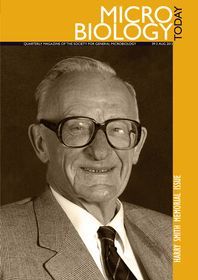Harry Smith Memorial Issue
01 August 2012 publication
When Professor Harry Smith passed away in December 2011, it was clear that the Society should pay tribute to him in the form of a special issue of Microbiology Today. Not only was Harry a Past President of the Society, but as a microbiologist he was universally respected across the world for his outstanding and influential contributions to our science. The articles in this issue cover the wide range and depth of influence that Harry’s work had on modern microbiology.
Harry Smith in Birmingham: past recollections and ongoing development (p. 154)
Charles Penn presents a personal view of Harry Smith and his legacy at Birmingham.
Pride in a century-long tradition of microbiology in Birmingham (p. 156)
As the new Institute of Microbiology and Infection at Birmingham opens its doors, Mark Pallen and Ian Henderson ask how has the legacy of Harry Smith been built upon?
Molecular mimicry and microbial physiology in neisserial pathogenicity (p. 160)
Harry Smith’s belief in the importance of in vivo studies led him to the discovery of the key determinants in pathogenesis, as Christoph Tang and Jeff Cole report.
Bacillus anthracis: despite what you have heard it’s not all bad (p. 163)
Les Baillie describes how the secret of Bacillus anthracis lies in the potency of its toxin, the central role of which in anthrax was discovered by Harry Smith.
Influenza research at Birmingham (p. 166)
As Clive Sweet points out, it should not be forgotten that Harry Smith carried out innovative research with influenza virus.
Gradline (p. 170)
Publications are one of the key indicators of success as a researcher (and an important part of your CV when applying for research positions). Karen McGregor explores two aspects of publishing your research – choosing the best journal to submit your manuscript to and the advantages of collaborating to boost your publication number.
Outreach (p. 174)
See how SGM won a Silver-Gilt medal and spread the word about microbes in the soil at the 2012 RHS Chelsea Flower Show.
Policy (p. 176)
The Campaign for Science and Engineering (CaSE) is an important non-governmental group that raises scientists’ voices in the political sphere. In this interview, Oxford biology graduate and CaSE Director Imran Khan explains why his organization matters.
Comment: Don’t destroy research (p. 188)
The recent demonstration against GM wheat at Rothamsted Research has highlighted the importance of communication between researchers and the public, opinion-formers and policy-makers as SGM President-elect Nigel L. Brown explains.
SGM journals go mobile
Managing Editor of Journal of Medical Microbiology, Melanie Scourfield, describes the latest feature of the online SGM journals.
Ferreting out the facts behind the H5N1 controversy (p. 178)
Recent recommendations by the National Science Advisory Board for Biosecurity (NSABB) to redact key methodological details of two studies involving mammal-to-mammal transmission of the H5N1 (H5) subtype influenza viruses, have led to a temporary moratorium on all research involving live H5N1 or H5 HA reassortant viruses shown to be transmissible in ferrets. What events led to this impasse and what will be the impact? Roy Sleator reports.
Deciphering infectious diseases (p. 181)
Humans have always made use of data encryption to communicate important messages. B. Cherie Millar and Peter J.A. Moore ask can modern-day forms of digital encryption, such as QR codes, be used to educate the peer group who are most at home with new technology about sexually transmitted infections?

